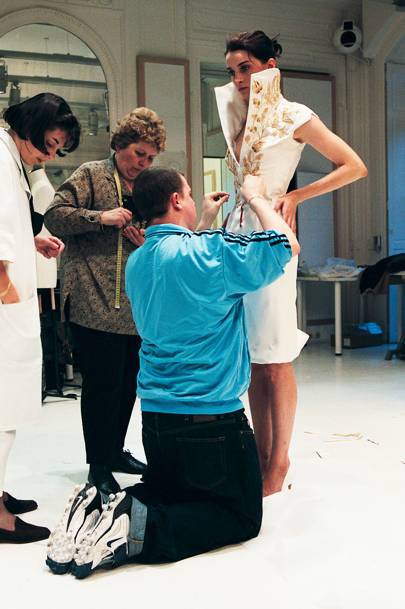It took one year of conversations with directors Ian Bonhôte and Peter Ettedgui to convince Alexander Lee McQueen’s former assistant, Sebastian Pons, to participate in McQueen, the documentary exploring the late designer’s legacy.
“I wanted to make sure it was going to be a respectful project, and a good portrait of the real Lee, not the other Lee,” Pons tells Vogue shortly before the film’s June 8 release date. “I was worried because Lee was my friend, Lee was my colleague, Lee was a lot to me, and I still like to protect him.”
Though the scar left from the designer’s suicide in February 2010 is still open – “I felt it had almost healed but then [Bonhôte and Ettedgui] start digging” – the voice of McQueen inside Pons’s head convinced him to share his memories. “It was so hard, but Lee told me to be strong in life.”
The pair met at Central Saint Martins in 1992, when Pons was an undergraduate and McQueen was finishing his MA degree. “I remember talking to him in the canteen,” Pons recalls of the daily minutiae of college, and watching with wonder as McQueen created his final collection. Years later, McQueen came across Pons’s graduate portfolio and commissioned him to create prints for his Hunger collection. “I used the Saint Martins printers, because Lee didn't have the facilities – or the money.” In 1997, when Pons graduated from his own MA programme, he went straight to work with McQueen at Givenchy. “I finished school on Wednesday, and on the Friday, I was taking a plane to Paris.”
The home video footage of McQueen’s rag tag gang running riot in the house of Givenchy, while enjoying the perks of having a private driver and a fancy apartment, is the focus of some of the film’s brilliantly candid scenes. “Givenchy called us the 'trash gang', because we were wearing bleached, slashed jeans and rock’n’roll tees in a couture house, but we just thought ‘enough of the French!’” Pons laughs. “Eventually [the atelier staff] said, ‘OK, these guys are crazy, but they are doing some spectacular stuff.'”

Pons stayed in Paris for 18 months on McQueen’s mission to gather information. “He said to me, 'Sebastian, you have to look at everything, you have to suck everything in, you have to make a lot of contacts, and then bring all this information back to our McQueen,'" he recounts. During that time, McQueen taught him “to not to be afraid of the unknown, to not always fall into the comfort zone of what we know, and to make decisions quickly” - a resolve he carries with him to this day.
Back in London as a permanent fixture at the house of Alexander McQueen, “Lee pushed the team into the unknown and encouraged us to mix weird elements into everything,” but Pons’s life was dominated by his boss’s mood. “Lee didn't come to work every day,” he tries to explain. “There would be two weeks of nothing, then some days he would be at his creative peak. He had to be balanced, he had to be calm and relaxed in order to perform, because he was so emotional. So emotional! Everything affected him – especially love.”
“If Lee’s love life was good, his designs were good,” he continues. “But if his love life was dark, his collections were dark.” Pons and the rest of the design team waited until McQueen’s temperament was favourable to show him the designs they had been working on. “We knew when the good days were good, and the bad days were bad,” he sighs, but, as time went on, it was difficult for Pons to tread the line between employee and confidante.
In 2000, Pons left McQueen to pursue his own fashion career in New York. “It was bad, because it was like a divorce,” he explains. “I got upset, he got upset… we didn’t talk it through.” But when Pons picked up the phone to call him two-and-a-half years later, it was as though time had never passed. “I loved the wild side of him from the beginning, and he knew I was devoted to him,” Pons shares. “I could talk about the Dante sleeve, or that piece from Highland Rape… But if I thought a collection was crap, I told him it was crap.” The foundation of their relationship was always, he says, honesty.
When asked what he misses most about this brotherly bond, Pons falters. Eight years on, it is still his laughter. “I miss Lee – not Alexander McQueen – I miss Lee. I miss his laughter... to just be with him.”
It’s this devastatingly honest account of a man that misses his friend, and the similar stories from McQueen’s colleagues, family and acquaintances, that makes the film such a sensitive depiction of a true individual, one who gave so much to British fashion, and to the people surrounding him.

Pons stayed in Paris for 18 months on McQueen’s mission to gather information. “He said to me, 'Sebastian, you have to look at everything, you have to suck everything in, you have to make a lot of contacts, and then bring all this information back to our McQueen,'" he recounts. During that time, McQueen taught him “to not to be afraid of the unknown, to not always fall into the comfort zone of what we know, and to make decisions quickly” - a resolve he carries with him to this day.
Back in London as a permanent fixture at the house of Alexander McQueen, “Lee pushed the team into the unknown and encouraged us to mix weird elements into everything,” but Pons’s life was dominated by his boss’s mood. “Lee didn't come to work every day,” he tries to explain. “There would be two weeks of nothing, then some days he would be at his creative peak. He had to be balanced, he had to be calm and relaxed in order to perform, because he was so emotional. So emotional! Everything affected him – especially love.”
“If Lee’s love life was good, his designs were good,” he continues. “But if his love life was dark, his collections were dark.” Pons and the rest of the design team waited until McQueen’s temperament was favourable to show him the designs they had been working on. “We knew when the good days were good, and the bad days were bad,” he sighs, but, as time went on, it was difficult for Pons to tread the line between employee and confidante.
In 2000, Pons left McQueen to pursue his own fashion career in New York. “It was bad, because it was like a divorce,” he explains. “I got upset, he got upset… we didn’t talk it through.” But when Pons picked up the phone to call him two-and-a-half years later, it was as though time had never passed. “I loved the wild side of him from the beginning, and he knew I was devoted to him,” Pons shares. “I could talk about the Dante sleeve, or that piece from Highland Rape… But if I thought a collection was crap, I told him it was crap.” The foundation of their relationship was always, he says, honesty.
When asked what he misses most about this brotherly bond, Pons falters. Eight years on, it is still his laughter. “I miss Lee – not Alexander McQueen – I miss Lee. I miss his laughter... to just be with him.”
It’s this devastatingly honest account of a man that misses his friend, and the similar stories from McQueen’s colleagues, family and acquaintances, that makes the film such a sensitive depiction of a true individual, one who gave so much to British fashion, and to the people surrounding him.




0 Yorumlar